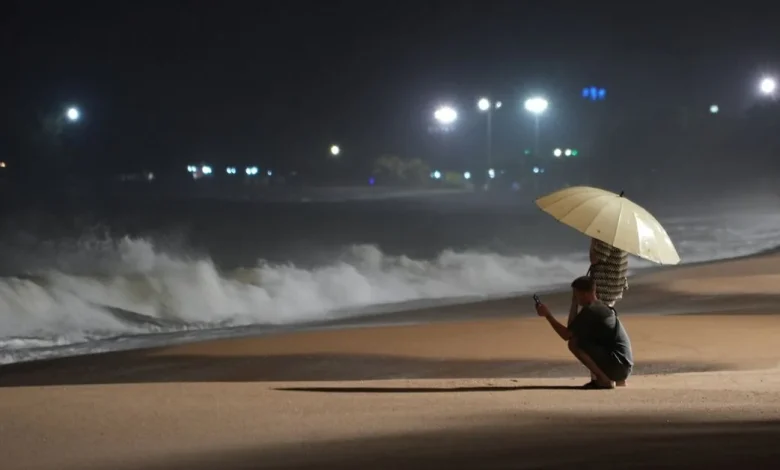Typhoon Kalmaegi hammers central Vietnam after battering the Philippines

Typhoon Kalmaegi brought fierce winds and torrential rains to Vietnam on Friday, days after the powerful storm battered the Philippines and left scores dead or missing.
Areas in central Vietnam reported damaged buildings, electricity polls and fallen trees as Kalmaegi weakened to a tropical storm and moved into Cambodia.
Vietnamese state media reported two deaths in Gia Lai and Dak Lak provinces.
People watch rough waves caused by Typhoon Kalmaegi in Khanh Hoa, Vietnam on Thursday, November 6. (AP)
In the Philippines, President Ferdinand Marcos Junior declared a state of national emergency on Thursday as another potentially powerful typhoon was expected to slam into the Philippines’ western coast Sunday night or Monday morning.
Kalmaegi left at least 188 people dead and 135 missing in the deadliest natural disaster to hit the country this year, the Office of Civil Defence said.
Kalmaegi is expected to move through Laos and hit north-east Thailand in the afternoon.
Thailand’s Meteorological Department advised people in the region to be cautious of heavy to very heavy rainfall that could lead to flash flood or river overflows.
Vietnam evacuates hundreds of thousands of people
A search operation was launched but later suspended due to worsening weather, state media said.
Authorities said more than 537,000 people were evacuated, many by boat, as floodwaters rose and landslides loomed.
Vietnam’s central provinces were already reeling from floods due to record-breaking rains.
Kalmaegi is forecast to dump more than 609mm of rain in some areas.
Residents carry a motorcycle along a muddied street caused by Typhoon Kalmaegi, in Liloan, Cebu province, central Philippines on Thursday, Nov.6, 2025. (AP Photo/Jacqueline Hernandez) (AP)
An unusually strong storm for the region in November, Kalmaegi packed sustained winds of about 183km/h with gusts reaching up to 220km/h over the South China Sea as it approached Vietnam.
Waves up to three metres high hit the coast in coastal cities like Danang, and strong winds uprooted trees in Dak Lak province.
Many homes in Quy Nhon, also a coastal city, were left without power for hours.
The country’s financial hub, Ho Chi Minh City, faced a heightened risk of severe floods.
High tides were expected on the Saigon River, and authorities warned up to 100 millimetres of expected rainfall could inundate low-lying areas.
Philippines braces for next powerful storm
Meanwhile, the next approaching storm, Fung-wong, was growing as it barrelled toward the Philippines over the Pacific.
State forecasters said Fung-wong, known as Uwan in the Philippines, could grow to a massive estimated 1400-kilometre diameter before it makes a landfall in northern Aurora province or nearby regions.
They warn that it could hit the densely populated area around the capital, Manila.
Residents walk along debris along a shoreline after Typhoon Kalmaegi caused devastation in communities at Talisay City, Cebu province, central Philippines, Wednesday, Nov. 5, 2025. (AP Photo/Jacqueline Hernandez) (AP)
Typhoon Kalmaegi displaced more than 560,000 villagers in the Philippines, including nearly 450,000 who were evacuated to emergency shelters, the Office of Civil Defence said.
More than 318,000 others are still in evacuation shelters.
Marcos was scheduled to visit Cebu on Friday, the hardest-hit central province, where the typhoon left 139 dead with 79 others missing.
“We suffered many deaths… it was very grave,” Marcos said on Thursday of Kalmaegi’s deadly aftermath, but he said “the biggest problem that we’re seeing is, we have to think who and how many of the personnel now handling government relief and support in the central Visayas region can be shifted to prepare for Uwan.”
In Cebu, rampaging floodwaters submerged or swept away scores of vehicles in scenes that were caught on camera by residents stranded on roofs.
Residents try to clean outside their damaged home filled with mud after Typhoon Kalmaegi caused devastation in communities along the Mananga River in Talisay City, Cebu province, central Philippines, Wednesday, Nov. 5, 2025. (AP Photo/Jacqueline Hernandez) (AP)
One of the mourners was Krizza Espra, who went to a mortuary on Thursday to see the bodies of her husband and three children, who were killed when the roof they were sheltering on collapsed.
She said four others in her family, including her mother and aunt, remain missing.
“I hope someone can help speed up the search for their bodies before (they) decompose, we hope we can still recognise them,” she said.
Marcos’s “state of national calamity” declaration allows the government to disburse emergency funds faster and prevent food hoarding and overpricing.
The Philippines experiences about 20 typhoons and storms each year.
The country also is often hit by earthquakes and has more than a dozen active volcanoes, making it one of the world’s most disaster-prone countries.
Vietnam, which gets about a dozen typhoons and storms a year, has been pummeled by a relentless series this year, leaving little time to recover between disasters.
Residents return to their damaged homes after Typhoon Kalmaegi caused devastation in communities along the Mananga River in Talisay City, Cebu province, central Philippines, Wednesday, Nov. 5, 2025. (AP Photo/Jacqueline Hernandez) (AP)
Typhoon Ragasa dumped torrential rain in late September, then Typhoon Bualoi slammed the central coast and Typhoon Matmo resulted in flooding in the north.
Together, the three storms left more than 85 people dead or missing in two weeks, and caused an estimated $1.36 billion in damage.
Vietnam is among the world’s most flood-prone countries, with nearly half its population living in high-risk areas.
Scientists warn that a warming climate is intensifying storms and rainfall across Southeast Asia, making floods like this year’s increasingly destructive and frequent.





